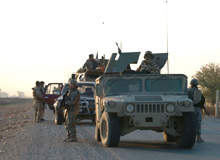
When President Obama set out his Afghanistan war strategy at the US Military Academy at West Point in December 2009, he made it clear that he wanted to transfer responsibility to Afghan leaders and security forces, and begin withdrawing American forces from the country in July 2011. To accelerate the process and meet this deadline, more American and international troops would be needed in the country in the intervening period.
The costs of being in Afghanistan have become a major burden for the US. Obama said in his strategy speech: “Our new approach in Afghanistan is likely to cost us roughly $30bn for the military this year, and I will work closely with Congress to address these costs as we work to bring down our deficit.”

Discover B2B Marketing That Performs
Combine business intelligence and editorial excellence to reach engaged professionals across 36 leading media platforms.
No one knows what the final cost will be on the day when the last US military personnel come home. But it is widely understood in Washington, and reflected in the new US federal budget assumptions, that rebuilding the economy of the US will be adversely affected by the costs of nation-building in Afghanistan.
Hidden casualty costs
There are some real costs, however, that are not even being calculated. Studies are establishing a strong relationship between fuel consumption and casualty rates due to fuel and water convoy protection. In November 2009, Deloitte released a report called “Energy security – America’s best defense; a study of increasing dependence on fossil fuels in wartime, and its contribution to ever higher casualty rates”, written by General Charles F Wald (USAF ret.) and Tom Captain (Deloitte’s vice chair). According to Deloitte, the study demonstrates that the development and use of alternative energy can directly reduce wartime casualties.
Its findings are echoed by the Army Environmental Policy Institute in a report titled “Sustain the mission project: casualty factors for fuel and water resupply convoys”. This study develops a methodology for calculating casualty factors for fuel and water resupply convoys in theatre operations in Iraq and Afghanistan.

US Tariffs are shifting - will you react or anticipate?
Don’t let policy changes catch you off guard. Stay proactive with real-time data and expert analysis.
By GlobalDataCasualties calculated include army soldiers and civilians killed or wounded while transporting fuel to consuming units and forward operating bases in theatre. The casualty factor for fuel resupplies in Afghanistan is 0.042, which is 0.042 casualties for every fuel-related resupply convoy or almost one casualty for every 24 fuel resupply convoys.
The report first tries to determine the proportion of resupply casualties related to fuel resupply. It estimates that an average annual load allocation for convoys in theatre in Afghanistan and Iraq is about 50% fuel, 20% water and 30% other in terms of volume. The average number of fuel-related casualties per convoy is calculated by dividing the fuel-related resupply casualties by the total number of fuel-related convoys.
The report provides the following important statistics:
In Afghanistan:
- Fuel transported in theatre in FY2007: 87,731,302gal or 2.1 million barrels
- Average capacity of a 16-supply-truck convoy: 97,818gal
- Number of full-up fuel convoys required a year: 897.
In Iraq:
- Fuel transported in theatre in FY2007: 502,110,368gal
- Average capacity of a 16-supply-truck convoy: 97,818gal
- Number of full-up fuel convoys required a year: 5,133.
A smarter metric would calculate the casualty factor per amount of fuel consumed. That metric is that every 55,702 barrels of fuel burned in Afghanistan by the US military forces corresponded to one casualty.
Reduce the resupply need
The report goes beyond casualty factors. Energy and water technologies, as well as increased use of energy efficiency, renewable energy and on-site water production in theatres of operations, can substantively reduce the need for resupply convoys, and therefore potentially reduce casualties without sacrificing operational effectiveness. The report calculates that a 10% reduction in fuel consumption over a five-year period could lead to a reduction of 35 fuel-related resupply casualties over the same period.
One important message emerging from the report is that a lighter system usually means a more fuel-efficient system, which means greater range and fewer fuel convoys. It concludes: “Greater range contributes to operational mission effectiveness and logistics sustainability; fewer fuel convoys reduce vulnerability, while providing cost and fuel savings, and freeing-up military resources for other missions.”
However, it acknowledges that a heavier weapon or support system usually means increased armour protection and less vulnerability, improving operational mission effectiveness while saving lives on the front line. It takes the mine-resistant ambush-protected (MRAP) vehicle as an example. The MRAP is a heavier, more formidable system, but fuel inefficient, therefore requiring more fuel convoys.
High-mobility multipurpose wheeled vehicles (HMMWVs), which are particularly susceptible to improvised explosive device (IED) attacks, have been replaced by MRAPs in many cases. In the short term this is an excellent force protection solution to the IED problem. However, the MRAP consumes significantly more fuel than the traditional (and up-armored) HMMWV and therefore requires more fuel resupply convoys.
It is clear from the report that military commanders will need to constantly negotiate this uneasy trade-off between vulnerability and fuel efficiency.





